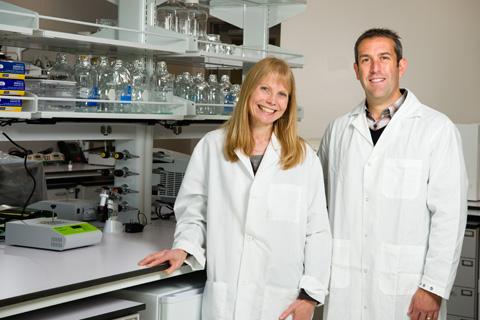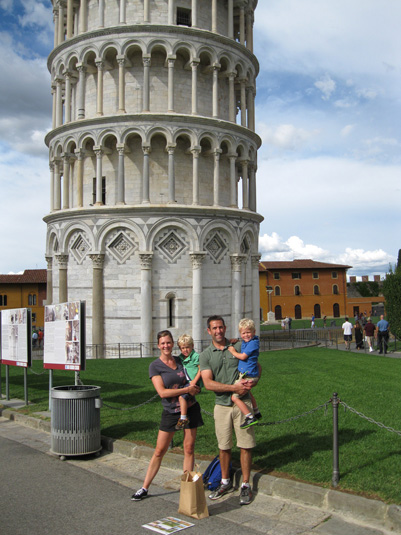
John Brognard, Ph.D., (right) pictured with Katherine Nyswaner, research biologist (left).
The Laboratory of Cell and Developmental Signaling (LCDS) recently welcomed John Brognard, Ph.D., as the new Earl-Stadtman Investigator.
While Brognard is new to this role, he is not new to NCI at Frederick. In high school, Brognard was a Werner H. Kirsten Student Intern in what was formerly known as the ABL research program, where he worked under Bob Moschel, Ph.D., senior investigator, and Gary Pauly, Ph.D., currently a staff scientist in the Chemical Biology Laboratory. Their research used E. coli to better understand the repair mechanisms that removed guanines modified at the O6 position with methyl, ethyl, or benzyl groups.
After his experience as a WHK intern, Brognard became hooked on basic research. He went on to earn a Bachelor of Science in chemistry from James Madison University and a Master of Science in biotechnology from Johns Hopkins University. He was also part of the laboratory of Phillip Dennis, Ph.D., at the National Cancer Institute in Bethesda, Maryland (Dennis is currently chair of the Department of Oncology at Johns Hopkins Bayview Medical Center).
From there, Brognard spent eight years in San Diego, where he earned his Ph.D. in biomedical sciences from the University of California, San Diego in the laboratory of Alexandra Newton, Ph.D., and trained as a postdoctoral fellow in the laboratory of Tony Hunter, Ph.D., at the Salk Institute (Newton is currently a professor of pharmacology at the University of California, San Diego and Hunter is the Renato Dulbecco Chair in Cancer Research and director of the Salk Institute Cancer Center). Finally, before returning to Maryland, Brognard spent six years at the Cancer Research U.K. (CRUK) Manchester Institute as a group leader.
When asked why he chose to return to NCI at Frederick, Brognard explained:
NCI at Frederick is a world-leading research institution dedicated to making both basic and translational research discoveries to aid in the development of better therapies to treat cancer patients. The beauty of the NCI and NCI at Frederick is that researchers are encouraged to take on high-risk projects that will truly lead to ground-breaking research that can impact all areas of science and also often translate into a better understanding of cancer and strategies to develop new therapies to treat cancer patients. There are numerous core facilities to tap into at the NCI and this really means your research and research ideas will not be limited. After performing research in many places around the world, the reputation of the NCI and the NCI at Frederick is one at the leading edge that engages in ground-breaking research, and I wanted to continue to be at an institute with that type of environment.
While Brognard joined the LCDS because of its great group of scientists, he was specifically drawn by its close proximity to the laboratory of Deborah Morrison, Ph.D., chief, Laboratory of Cell and Developmental Signaling. All of his former mentors held Morrison in the highest regard, and her contributions toward understanding signaling in the RAS/RAF/MEK/ERK pathway have aided in developing therapies to treat patients with activating mutations in RAF or MEK (which is present in many cancers, including over 50% of melanoma patients).
The opportunity to have a lab at the NCI, especially so close to hers, was one Brognard simply couldn’t pass up.
At the LCDS, he’ll focus on elucidating novel cancer-associated kinases in the unexplored kinome, guided by bioinformatics and functional genomic approaches, with the goal of understanding the molecular mechanisms utilized by these kinases to promote tumorigenesis.
His team will then translate these findings to the clinic and encourage drug development programs focused on these novel targets. Brognard’s lab hopes to provide a platform for transformational research that will help identify novel druggable drivers, ultimately leading to precision medicine–based targeted therapies that will benefit the vast majority of cancer patients. Their research should identify new genetic drivers, targets for therapeutic intervention, and novel mechanisms of tumorigenesis.
Outside the lab, Brognard enjoys outdoor activities such as hiking, running, camping, fishing, and especially skiing. In fact, if he had to choose an alternate profession, it would be ski instructor.
He also loves to travel and has a long list of favorite travel spots. Banff and the west coast of Norway, specifically the Geirangerfjord area, are great for mountain getaways, he says. For skiing, he loves the French Alps area, including Le Grand-Bornand and the Grand Massif ski areas. And he says there’s no better place for fishing than his father’s cabin in Quebec.
Of Brognard’s career coming full circle from WHK intern to head of an NCI lab, Howard Young, Ph.D., senior investigator, Cancer and Inflammation Program, said, “I think it is a wonderful example and tribute to the intern program that a former intern has returned to head his own lab. It demonstrates that exposure to the quality science performed at NCI at Frederick can impact careers in ways that benefit and enhance the future of biomedical research.”



